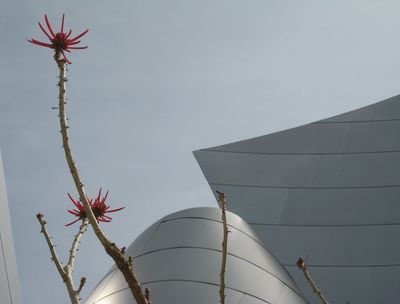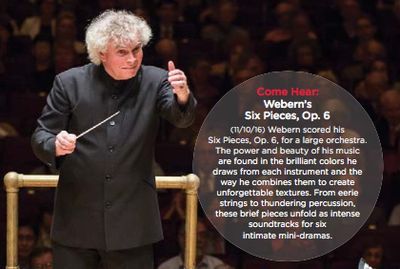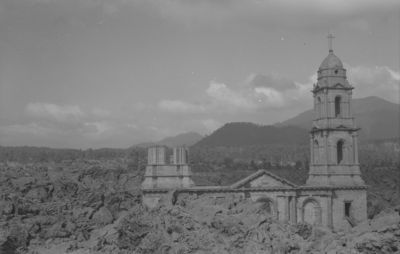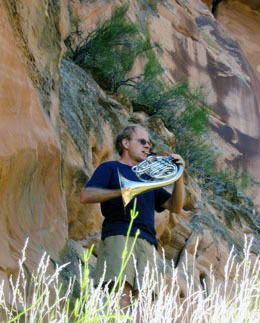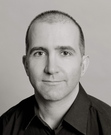Alex Ross's Blog, page 103
March 3, 2016
Dept. of losing battles
On this week's episode of the miniseries The People v. O.J. Simpson, Detective Mark Fuhrman, whose history of racial epithets helped to doom the prosecution of Simpson for double murder, is seen polishing his display case of Nazi memorabilia while the Meistersinger Prelude plays on the soundtrack. Apparently, Wagner is responsible not only for the Holocaust but also for systemic racism in American police departments.
March 2, 2016
An Iannotta moment (und Adams ist auch dabei)
The Italian-born composer Clara Iannotta, presently dividing her time between Berlin and Cambridge MA, transfixed an LA Phil Green Umbrella audience last night with the above-embedded work, Intent on Resurrection — Spring or Some Such Thing. It was part of an engrossing and far from conventional program, selected by John Adams and conducted by Mirga Gražinytė-Tyla, that also included the world première of Annie Gosfield's Refracted Reflections and Telepathic Static, the American première of Chaya Czernowin's Knights of the Strange, and performances of Nancarrow's Sonatina and Lutosławski's Paganini Variations by the adventurous piano duo Michelle and Christina Naughton. The Naughtons have a new recording of Messiaen's Visions de l'Amen on Warner Classical; the disc also includes Adams's Hallelujah Junction and Bach's "Gottes Zeit ist die allerbeste Zeit" in the Kurtág arrangement. They will appear at WQXR's Greene Space on March 23, playing the Messiaen alongside a semi-new Adams piece called Roll Over Beethoven (Preben Antonson's arrangement of Adams's Second Quartet).
March 1, 2016
Here we go again
A Cultural Comment on reactions to Wagner at the Oscars.
February 23, 2016
LA Phil 2016-17
The LA Philharmonic has announced its 2016-17 season, and, as usual, it makes most other orchestras look dull by comparison. There are twenty-one commissions and fourteen world premières, including new works by Kate Soper, Mario Diaz de León, James Matheson, and Gerald Barry (an evening-length piece entitled Alice's Adventures Under Ground). The major festival offering is a week of music from Iceland, co-curated by Esa-Pekka Salonen and Daníel Bjarnason. Gustavo Dudamel focuses on older fare, surveying Schubert symphonies, Mahler orchestral songs, and the Bartók piano concertos (with Yuja Wang), although he also addresses a number of contemporary works, including Andrew Norman's sprawling Play. The Schoenberg family will be happy to see the master's Piano Concerto sharing space with Mozart. John Adams's seventieth birthday is marked by performances of El Niño and Nixon in China. Thomas Adès is on hand to conduct his Totentanz and the Barry première. And Hopscotch mastermind Yuval Sharon, beginning a term as "artist-collaborator," presents an evening of Schubert songs and Beckett plays, featuring Ian Bostridge, and a staging of Lou Harrison's pioneering gay opera Young Caesar. The schedule is light on female composers, although that may change as more details of the Icelandic festival are announced. Deborah Borda, the orchestra's president, told Richard Ginell of Musical America that "Björk might well be appearing with the Iceland Symphony."
Across the street, LA Opera's 2016-17 season doesn't lag too far behind, featuring Glass's Akhnaten, Ted Hearne's The Source, a new Matthew Aucoin score for Murnau's Nosferatu, and Bernstein's Wonderful Town.
February 22, 2016
Brochure of the month
I've often complained about a classical-music marketing syndrome that might be called John Adams Conducts Respighi: the tendency to advertise concerts in a way that actively conceals new or unfamiliar works, as if they were mistakes to be covered up. If you want to bring audiences round to non-standard fare, you need to own it, take pride in it. So it was a pleasure to pick up Carnegie Hall's 2016-17 brochure, emblazoned with the words "Come Hear," and find that on many pages it is the new, unusual, lesser-known, or ostensibly "difficult" piece that is highlighted and briefly explicated: Vivaldi's Juditha triumphans, Webern's Pieces Opus 6, Adams's Gospel According to the Other Mary, Cage's The Seasons, Benjamin's Dream of the Song. In an inversion of the usual practice, a Boston Symphony program containing the "Eroica" is singled out on account of Gunther Schuller's Seven Studies on Themes of Paul Klee. More of this, please!
February 21, 2016
David Lang's Hollywood adventure
Fish Out of Water. The New Yorker, Feb. 29, 2015.
February 20, 2016
Miscellany
Photo: Parícutin, 1943, by C.S. Ross, USGS
There will be a major Kaija Saariaho première at the Netherlands Opera on March 15, with Peter Sellars directing: Only the sound remains, a pair of pieces inspired by Nôh drama. Philippe Jaroussky will sing the lead role, for countertenor. The work will also be heard at the Sellars edition of the Ojai Festival in June, this time with Anthony Roth Costanzo.... Peter Margasak, longtime music writer for the Chicago Reader, curates the experimental Frequency Series at Constellation in Chicago. Next week he will present a six-day festival, featuring the Fonema Consort playing Lachenmann, Kagel, and Maiguashca; a.pe.ri.od.ic playing prose scores; Mocrep playing Maximilian Marcoll and Mathias Monrad Møller; Tim Munro playing Sciarrino's L'opera; Claire Chase playing some of her recent "Density" commissions; the Spektral Quartet playing Thomalla and Furrer; and Ensemble Dal Niente offering a “Hard Music, Hard Liquor” program of George Lewis, Furrer, Barrett, and Sivan Cohen Elias.... Wandelweiser west: Manfred Werder appears tonight at The Wulf in LA, in a program including Werder's 20161, Michael Pisaro's A certain species of eternity, and Christian Wolff's Metal & Breath.... Also in LA, on March 1 the Green Umbrella series will present an Annie Gosfield world première and a Chaya Czernowin U.S. première (Knights of the Strange), with Mirga Gražinytė-Tyla conducting.... A few decades ago, the sound artist Bruce Odland came across an ultra-reverberant water tank outside Rangely, Colorado. Having saved the tank from being scrapped in 2013, Odland and allies are now seeking funds to open the space as an international arts center.... On Feb. 23, Lisa Moore will give a live rendition of her new Cantaloupe CD The Stone People at LPR in NYC: works of Missy Mazzoli, Kate Moore, Julia Wolfe, John Luther Adams, Frederic Rzewski, and Martin Bresnick.
February 19, 2016
Kurtág at 90
In France, the literary world once elected the "prince des poètes" — the unofficial master of the game. The title "prince des compositeurs," shorn of gender, might go to György Kurtág, who celebrates his ninetieth birthday today. Above is his most recent work, Petite musique solennelle en hommage à Pierre Boulez 90, which was written for Boulez's ninetieth and which now sadly doubles as a memorial. An admiring world wishes Kurtág the best of health as he works on his opera Fin de partie, scheduled for a première at La Scala in November. Editio Musica Budapest has published a birthday greeting from Simon Rattle and a video of Kurtág playing Bach with his wife, Marta — "the most incredible team in classical music," as Rattle properly says. There will be a live stream of the Petite musique from the Berlin Philharmonic tomorrow, with Rattle conducting.
Previously: Hold the Mozart.
February 17, 2016
Canyons in the canyon
When I was working on a column about the St. Louis Symphony's magnificent performance of Messiaen's Des Canyons aux étoiles, I saw mention of a story about Roger Kaza, the orchestra's principal horn. In 1982, Kaza had played the Appel interstellaire, the work's great solo-horn movement, in a branch of the Grand Canyon, and had sent a recording of the feat to the composer. Adam Crane, the St. Louis's vice president for external affairs, put me in touch with Kaza, who sent me a remarkable memoir of the event. I asked if I could publish it on the blog; he consented, and here it is.
"Messiaen’s Canyons, in the Canyon"
by Roger Kaza
I first heard about Olivier Messiaen’s Des canyons aux étoiles… (From the Canyons to the Stars…) in 1974, the very year it was written. I was nineteen years old. An enthusiastic church organist in my hometown of Portland, Oregon was going on about it. “It’s got a huge horn solo,” he exclaimed. This struck me as improbable. I knew the composer’s iconic Quartet for the End of Time, with its solo clarinet movement, but could hardly imagine a work of such depth and quality for solo horn. If it did exist, neither I nor anyone I knew had seen the music. For years, the mythical Messiaen movement lingered in the back of my mind, like one of his reclusive birds.
Eight years later, however, curiosity returned. A group of us were planning a three-week self-guided raft trip down the Colorado River in Grand Canyon. I had applied for a National Park Service permit about four years earlier, and the long-awaited adventure was finally on the horizon. A number of musicians were going, including trumpeter Tim Morrison—who became John Williams’s soloist of choice in movies like JFK and Born on the Fourth of July—and violist/singer Lorraine Hunt, later of operatic legend. In addition to rafting and camping, we planned to explore side canyons and test the acoustics of the world’s most famous canyon. What better piece to play than the Messiaen Canyons, if it existed?
I contacted a hornist friend in Paris, who said he had the music. He was supposed to send it to me but never did. Running out of time, I wrote to my former horn teacher in Seattle, Christopher Leuba. Chris, former solo horn of the Chicago Symphony, had been the page turner for what was likely the US premiere of the Quartet for the End of Time, at Tanglewood, in 1949. He’d not heard of Canyons or its horn solo, but said he’d check the music library at the University of Washington.
Miraculously, the music arrived in the mail the day before the trip. It was a copy of the score, in tiny print, in C alto (concert pitch). Horn is normally pitched in F, so this required a little-used transposition, up a perfect fifth. I finally learned the title: Appel interstellaire, it was called…an Interstellar Call. There were a few quotes from Scripture on the title page, from Psalms and the Book of Job. The music seemed to have no meter, and the minuscule note values were to be played at glacially slow metronome marks. Merely in terms of deciphering it, my work was cut out for me. We launched on Sept 12, 1982.
At first, I spent a long time just looking at the page. Notes were grouped irregularly, often in patterns of five. It gave a sing-song quality to the lyrical sections, but required lots of math to play. One had to be careful not to “quantize” the rhythms into something familiar but wrong. As our rafts drifted through the towering Colorado canyons, I tried to sing the music in my head.
In addition to Lorrie (as we knew her then) and Tim, there were some guitarists in our group. Others aboard, such as my sister Stephanie, were capable singers. Lorrie had an odd trove of old ditties, rounds and folk songs she taught us, and eventually we had enough material for a concert, which we presented on a sand bar for another group of rafters, who rewarded us with dessert (or beer). My contribution was Wagner’s famous call from Siegfried, where the hero wakes the dragon Fafner. I continued to work on the Messiaen, though my chops were getting flabby from days on the river with little time to practice. We ran the wild rapids, camped, hiked, partied, and tested acoustics wherever we could.
Finally, at mile 168 (measured from the put-in at Lee’s Ferry, Arizona), we found our ideal space. Fern Glen Canyon is a tributary of the Colorado, with hundred-foot vertical walls thirty to fifty feet across. Dripping springs create grottoes of ferns, greenery, and delicate wildflowers. Tim and I hiked up the canyon, played a few notes, and immediately reveled in the lush echo resounding off the ancient stone. This was the place to record the Messiaen. We convinced the group to stay an extra day, so we could carry out our recording project.
The next day, Tim and I started with some improvisations and made-up duets. We’d both grown up in Oregon, both of us sons of band directors named Eugene, and we had joined the Boston Symphony at the same time. We once did a recital together where the program contained only one bio for us, since so much was in common.
Then I attempted the Messiaen. By now it was dark and the crickets were chirping. The strange tritone-infused music, with its weird lilting rhythms, seemed perfectly suited to this hallowed place of rock and time. Because my chops were weak, I had to record it piecemeal. Fortunately, the music contains many long pauses and lends itself to such an approach. After an hour or two of retakes, I decided that everything should be covered. We packed up the sand-infested Walkman and hiked back to camp.
After the trip, a friend with some recording equipment helped me edit the tape. We dubbed it onto reel-to-reel tape and spliced it with a razor blade. Almost all of it was more or less OK, except for one spot where the cassette motor was clearly struggling to stay steady. Sand in the machine had caused a strange grating noise as well. But it was all there, at least. After compiling a complete version, I used the recording as part of a slide show of the trip, accompanying a series of abstract photos of rocks and boulders.
Fast forward eight more years: Messiaen serendipity struck again. It had never occurred to me that the composer might want to hear this canyon-inspired version of his piece; in any case, it could not be my last notes on the subject, since it been learned so hastily. But at a musical event in St. Louis, where I was now working, a grad student casually mentioned he had done his dissertation on the composer. “Do you happen to have his address?” I found myself asking. “Well, yes, but he’ll never write to you.” “Ok, just give it to me anyway.”
I’d had bad luck sending tapes overseas, because they tend to get erased by mail-scanning metal detectors. But a friend was going to Paris, and I asked her if she’d hand-carry the tape and mail it locally, which she did. I enclosed a short note, in English, explaining the genesis of it.
Perhaps three weeks later, I received a delicate airmail postal envelope, addressed in elegant script. The letter read:
Yvonne LORIOD-MESSIAEN
230 Rue Marcadet 75018 Paris (France)
17 Juin, 1990
Cher Monsieur!
Merci pour votre lettre et votre cassette!
Mon mari Olivier Messiaen vous remercie d’avais joué le solo du cor des “Canyons aux étoiles” devant le Grand Canyon. C’est une idée touchante qui l’a bien ému!
Vous jouez bien…mais trop vite. C’est un “appel,” suivi de beaucoup de silences. (Attente des réponses) et le theme est plus lent et plus expressif, comme une mélodie implorante.
En tout cas, merci de votre idée si gentille!
Avec nos meilleurs sentiments.
Yvonne Messiaen
Which translates more or less as follows:
Dear Sir!
Thank you for your letter and your tape!
My husband Olivier Messiaen thanks you for playing the horn solo of “From the Canyons to the Stars” to the Grand Canyon. It is a touching idea that has moved us!
You play well... but too quickly. This is a "call, " followed by many silences. (Wait for answers) and the theme tempo is slower and more expressive as a heartfelt melody.
Anyway, thank you for your very nice idea!
With our best wishes.
Yvonne Messiaen
I later realized that they may have thought I played devant (“in front”) of the Grand Canyon, rather than in it. Of course, there would be zero acoustic in such an environment, though the dramatic visual effect might make up for it. In any case, I was glad he got the tape. The composer died two years later. Lorraine passed away in 2006. Their songs live on. In 2016, I finally played the Appel interstellaire in a performance of the caomplete work, with the St. Louis Symphony. A long and very strange raft trip it had been.
Shame-inducing headline of the year
Alex Ross's Blog
- Alex Ross's profile
- 425 followers


